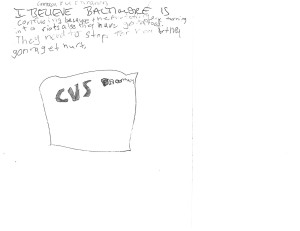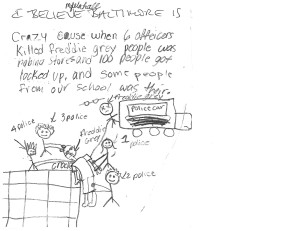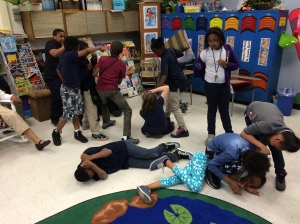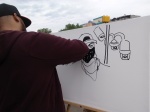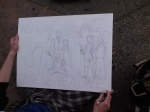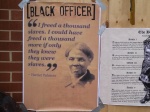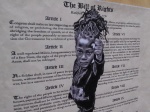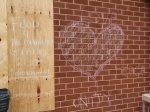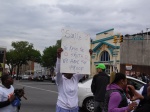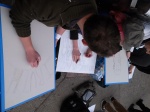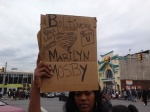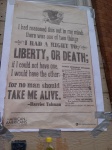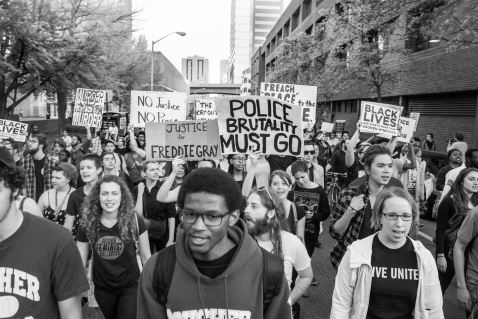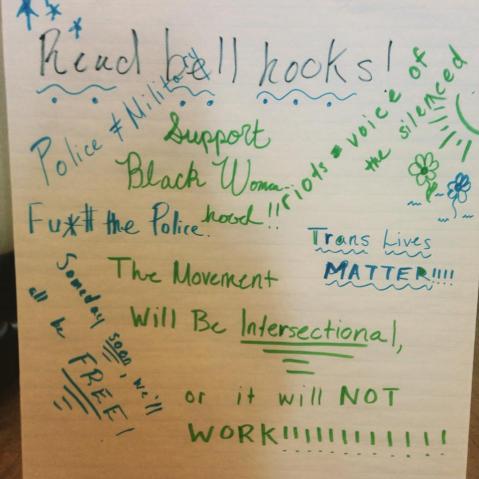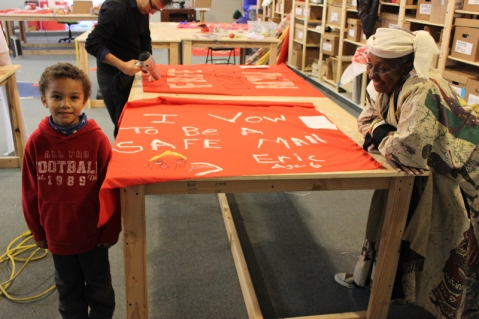Artists Within Spotlight: Y-LLEAD – Healing the Self to Heal the Community

Created by designer and activist Melissa Moore, the Youth Learning Lab of Education and Applied Design (Y-LLEAD) in Greenmount West is a youth-led + intergenerational supported design, build, and community activation program.
A typical Y-LLEAD session begins with setting an intention and closes with similar activities. Youth participant Talayia Bowman explains, “We come and sit in a circle to keep our energy and circulation between us. We start with our meditation/contemplation practice where we ground our feet and sit in an upright position with our backs erect… It’s beneficial. We are still young and pulled in a lot of directions but this helps us be more open to what we want to be, kind and decent to other people.”
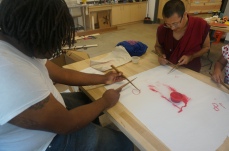 Bowman also described the benefits of being in an intentional collaborative learning environment. “I’ve been in programs where the ripple effect only lasts as long as the duration of the program, but here, this is stuff that directly deals with how we view society and how we carry ourselves.” Bowman smiled, and then continued, “I deal with regular challenges… when I leave here, it’s like taking a little ball of optimism outside into the world with me. Being young, people don’t expect us to think through stuff as much as we do. Design thinking means taking something apart layer by layer. This program has helped me learn how to unpack hard situations and I can use [these skills] as soon as I hit the sidewalk outside. Overall I would describe my experience as enlightening,” Bowman explained. “What makes [Y-LLEAD] different is how it is run. Most programs lie about wanting participants to have a voice, but this place does not.”
Bowman also described the benefits of being in an intentional collaborative learning environment. “I’ve been in programs where the ripple effect only lasts as long as the duration of the program, but here, this is stuff that directly deals with how we view society and how we carry ourselves.” Bowman smiled, and then continued, “I deal with regular challenges… when I leave here, it’s like taking a little ball of optimism outside into the world with me. Being young, people don’t expect us to think through stuff as much as we do. Design thinking means taking something apart layer by layer. This program has helped me learn how to unpack hard situations and I can use [these skills] as soon as I hit the sidewalk outside. Overall I would describe my experience as enlightening,” Bowman explained. “What makes [Y-LLEAD] different is how it is run. Most programs lie about wanting participants to have a voice, but this place does not.”
 Using a combination of healing practices and design thinking, Y-LLEAD helps participants and facilitators work together to solve complex social problems. Y-LLEAD learning exchange facilitator Thea Ganlas said, “We spend a lot of time really listening and hearing everyone’s voice. It’s therapeutic for me and it’s almost unfair to get paid for doing it. We learn how to approach communal work. We talk about everything. We see this space as safe and whatever we bring to it, we deal with in the healthiest way possible. I have not seen this work out with other programs – other programs I’ve been a part of were focused on the business end of the work, not the healing that can come through doing arts-based practice.”
Using a combination of healing practices and design thinking, Y-LLEAD helps participants and facilitators work together to solve complex social problems. Y-LLEAD learning exchange facilitator Thea Ganlas said, “We spend a lot of time really listening and hearing everyone’s voice. It’s therapeutic for me and it’s almost unfair to get paid for doing it. We learn how to approach communal work. We talk about everything. We see this space as safe and whatever we bring to it, we deal with in the healthiest way possible. I have not seen this work out with other programs – other programs I’ve been a part of were focused on the business end of the work, not the healing that can come through doing arts-based practice.”
As a facilitator, Ganlas sees Y-LLEAD as a chance to be an ally in communities that are not her own. “I came to Baltimore as a student. I did not feel connected to the neighborhoods because I stayed inside of a bubble. It is really easy to do. I decided finally that I should find out what it means to live in Baltimore and not let others speak for those experiences. Being a part of Y-LLEAD helps me feel connected to the city I have decided will remain home for now.”
As a Baltimore native, youth participant Bowman offers another perspective on allyship. “I don’t live around [Greenmount West] and a few months ago I would have been like, ‘I don’t live around here, I don’t hang around here and I don’t care about what goes on around here.’ But now I realize I don’t have to live here to care about the neighborhood.”
Artists Within Spotlight: Single Carrot Theatre Arts Integration in an Uprising

Forging community connections takes time, flexibility and mutual respect. As a part of the Artists Within Coalition, Single Carrot Theatre (SCT) has been learning this first hand through teaching theatre in Baltimore schools and hosting weekend theater workshops for neighborhood youth in their 2600 North Howard Street location. In January 2015, SCT began providing weekly workshops to high school students at the Community School in Remington. They partnered with Margaret Brent Elementary/Middle School in March to provide onsite, weekly theatre workshops in conjunction with Margaret Brent Elementary/Middle’s efforts to combine arts content and skills with other core subjects.
Building this collaboration began a year ago with a request from Margaret Brent Elementary/Middle to use SCT’s space for the school’s end-of-year closing ceremony for 5th and 8th graders. According to SCT Managing Director Elliott Ruah, “what was more important was our desire to connect with students and parents in the surrounding neighborhoods. Not just to have them know where the space is but for them to have a positive experience in our space.”
Creating the relationship with Margaret Brent Elementary/Middle required persistence. “As actors and art educators, we knew our best strategy was to simply keep showing up,” Rauh said. “Once the principal understood we were open and ready to help, we met with them once a week for five weeks in Fall 2014 to begin our work in Spring 2015.”
It was fateful timing.
When the Baltimore Uprising began in late April, SCT had been steadily working with the students, teaching them to express their emotions and thoughts through theatre exercises. In the aftermath of the uprising, SCT staff saw their young performers reveal the impact of the unrest on their lives.
“We first didn’t want to force anything on them. We just wanted to help them reflect how they were actually feeling,” said Jessica Garrett, SCT’s Director of Public Relations & Education. “This was especially important because we are working with children from Pre-K to 14 years old.”
SCT asked students to express their thoughts using a writing exercise, answering the prompt, “I believe Baltimore is…”
- I believe Baltimore is confusing.
- Dirty, ghetto and not safe.
- Crazy because of what happened.
- Crazy cause six officers killed Freddie Gray.
- Crazy cause when Freddie Gray got killed, everybody went crazy.
Using a mix of tableaus and standing statues, they asked youth to physically express what they believed was happening in Baltimore, answering the prompt, “If Baltimore was a person, show me how Baltimore feels today?”
- Tableau 1
- Tableau 2
- Tableau 3
“So many students wanted to be Freddie Gray,“ Rauh explained. “They knew that name. It was the take-away name… Children directed each other and designated who the cops were, who the protestors were and what kinds of things they could throw.”
Students then analyzed the tableaus and identified what was happening. Youth assigned their classmates as cops and protestors depending on the racial mix of the group.
In the final tableau, students were tasked to show Baltimore at peace.
“This was our attempt to create a curriculum that did not ignore what was going on,” Rauh said. “We didn’t want to sit them down and explain what the incidents were about. We wanted them to show their understanding through their own bodies and reflection. For me personally, it made me feel more connected to the Uprising because I had a forum to see what the kids were taking away from it all. I was blown away by how young some of the kids were and how aware they were of the dynamics of the situation. Awareness starts early in Baltimore.”
SCT hopes to continue their collaboration with Margaret Brent Elementary/Middle throughout the upcoming school year. Check out their website to know more about their work and to support their efforts.
Baltimore Uprising Art Archive Series 4: North and Penn Visual Artists and More
“Know justice. Know Peace.”
Prior to Mariyln Mosby’s announcment that the six officers involved in Freddie Gray’s murder would be arrested, local artist had already taken over the corner of North Avenue and Pennsylvania to make art. When the news came down – solemnity turned into a party. Here are some photos of the artists working, reclaimed street art and protests t-shirts.
More images and video to come!
Baltimore Uprising Art Archive: Series 3 – Youth Voices
“Be a voice – not an echo.”
Check out some great video of youth voices from Baltimore’s artists, activists and provocateurs.
Check out this collaboration between Wide Angle Youth Media and Youth Radio International: Baltimore Youth Voices!
Tomorrow Get Involved! 1:30pm-3:30 pm Hold the Police Accountable March with the Gray Family! For more information visit BmoreUnited.
Baltimore Uprising Art Archive: Series 2
This gallery contains 3 photos.
“When the water is boiling, its foolish to take it off the heat.” – Nelson Mandela This is a living archive designed to highlight the cultural production efforts of Baltimore’s citizens in response to the Baltimore Uprising. Please contribute your images of protests signs, homemade t-shirts, clothing, photos of art making, stencil images — anything reflective of […]
Baltimore Uprising Art Archive: Series 1
This gallery contains 4 photos.
Originally posted on Baltimore Art + Justice Project Blog:
“Art is not the handmaid of politics. It is its own remedy! And its healing is sacral.” – William Everson Today begins a series we are dubbing the Baltimore Uprising Art Archive. It is a living archive designed to highlight the cultural production efforts of Baltimore’s citizens…
Baltimore Uprising Art Archive: Series 1
This gallery contains 6 photos.
“Art is not the handmaid of politics. It is its own remedy! And its healing is sacral.” – William Everson Today begins a series we are dubbing the Baltimore Uprising Art Archive. It is a living archive designed to highlight the cultural production efforts of Baltimore’s citizens in response to the Baltimore Uprising. Please contribute […]
A Chance to Think Outside of the Box With Y-LLEAD, An Artists Within Spotlight
The Baltimore Design School sits nestled in the heart of Greenmount West, a neighborhood in the Station North Arts and Entertainment District. Down the street from the City Arts Building and across from Area 405, young people in the Baltimore Design School are surrounded by a growing cultural community of low, middle and high income families, artists, commuters and laborers.
A program that is helping to expand the cultural impact of youth in the neighborhood is the Youth Learning Lab of Education and Applied Design (Y-LLEAD) created by designer and activist, Melissa Moore. A member of the Artists Within coalition, Y-LLEAD is a youth led design program that uses architecture, product and graphic design as a tool for social justice and self-actualization.
On a winter visit to Y-LLEAD’s after school program in the Baltimore Neighborhood Design School, two youth participants, Kirsten German (19), and Monica Dickens (13), spoke of having an opportunity few youth in Baltimore are given – the chance to think outside of the box.
When my mother told me about the chance to become involved in graphic design and architecture, I thought, I’d never done it before but why not take a chance? It’s like a very versatile skill- designing. You can do anything. I haven’t had a lot of chances to just…do what I want.
Kirsten’s quiet statement was seconded by Monica, who spoke of Y-LLEAD as her chance to have her ideas taken seriously.
I became involved this summer because it was different. You get to say your ideas and then, try them out.
Y-LLEAD’s participants describe their experience as a chance to move away from after school programming which regularly involves top down instruction. Instead, hands on design opportunities are helping them grapple with big ideas and turn them into practical objects.
It’s a very enlightening experience. It takes you out of your comfort zone – you don’t have anybody dictating what is right or wrong. It’s like you are given a blank canvas you can mark on all you want. It’s something new to me, not having direction.
The blank canvas framework also allows them to think about obstacles as opportunities.
We get to share ideas. The objects we make don’t always end up being used for their original intent. We have to learn how to work with each other and be flexible. You can share your ideas openly. When we run into a problem, it’s like what you think- just try it out. It’s like the way the real world is- you don’t get directions, you just stumble through it.
Not only are Y-LLEAD participants learning how to turn challenges into opportunities, they are also learning how to be responsive to the community around them.
We work with the community to find out what they need and give them what they need. It’s not hard. It’s engaging and gives me something to do that I have not been able to do. It makes feel like I’m a part of a collective vision. It makes me feel useful. I don’t have many other chances in my life where I feel really useful.
In the end, Y-LLEAD is not only helping participants feel valuable and connected to one another, it is also helping them to appreciate their own minds.
As teens, we are always told what to do, but with Y-LLEAD, every day is a learning experience- I have learned to think for myself. Thinking for yourself is hard work but it’s worth it.
Artists Within Spotlight: A Common Thread, Generational Healing Through Quilt Making
“My experience today has been one of being with strangers who aren’t strangers. There is a common thread that has us all in the room.”
In late November, FORCE: Upsetting Rape Culture (FORCE) invited community members, organizers and artists to their 1400 N. Greenmount Avenue warehouse to create a quilt square in solidarity with Marissa Alexander. Marissa was being threatened with 60 years in prison in Florida for firing a warning shot to protect herself from her abusive husband and the quilt square, joined by a banner, was being created to be displayed in Florida at her pending trial.
FORCE is organized by artist-duo Hannah Brancato and Rebecca Nagle. The project is a creative activist collaboration to upset the culture of rape and promote a culture of consent by creating art actions to generate media attention and get millions of people talking. As members of the Artists Within coalition, FORCE collaborates with local artists and community groups to host a series of healing art events and quilt making workshops in their Station North studio to engage survivors and local residents.
On this sunny, blustery afternoon, participants of all races, ages and genders spent their day painting in collaboration, sewing, and quietly crafting their own stories of survivorship. One workshop participant, a self-described African American “elder” named Olu, brought her six year old grandson, Eric to the studio to create his own quilt square.
This straight forward and powerful statement was crafted by Eric. As a caring grandmother, Olu sees this statement as the beginning steps on the path to addressing and healing generations of hurt.
He [Eric] is the offspring of multigenerational survivors. His being here, his having thought about and wrote those words, means everything. I teach that no matter what the thought is, if you don’t say it, you don’t have to own it. Once you say it, the vibration of your body has produced the words and you are responsible for it. He said and wrote – “I vow to be a safe man”. That seed planted will be a tree that grows.”
Olu became interested in the November workshop after participating in a FORCE “Take Back the Night” event earlier in 2014 where she shared her own story of survivorship. When given the opportunity to reconnect with the project, she caught a taxi across town. She was moved to bring her grandson because, as she said on that late November afternoon, “if patterns are going to change we are the ones to do it”.
Olu sees it is paramount to have a physical space to acknowledge and support survivors of sexual assault.
[At the workshop] we all know something about each other. We don’t have to speak it, we just know. I watched folks painting. I watched them gripping of the brush, I watched their struggle. I knew more than maybe I wanted to know about them but that is why we are doing this. Does that quilt not say, “You are not alone”? There are people who have not said hello to me and I have not said hello to them, but we have a collective pain that we are supporting each other through in this space. There is something to be said about that. What is valuable is knowing that this kind of thing helps, little by little by little. Statistics may not fall off because we do this, but every time we do, someone is made more aware of it.”
By opening its doors in Station North to the community for quilt making and healing workshops, FORCE: Upsetting Rape Culture, is helping entire families confront generations of silence around sexual assault.
As Olu describes,
[Eric] is the offspring of multi-generational survivors. What we didn’t know, what we didn’t teach, whatever we missed – I’m not carrying that pattern forward. He is not too young to know that there are people who can cause pain beyond shooting or stabbing people. He is not too young to know that, just as he has the right to have his body safe, he is never to violate someone else’s. He’s not too young to know that. We can’t talk about the protection of little girls without talking about the re-education and protection of little boys.
Artists Within Spotlight: Coming Out – Dance, Memory and Hope at J. Van Story Branch
“We have seniors here that have been here for years and they don’t want to come out and mix with 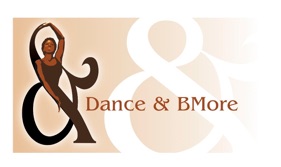 the new population.”
the new population.”
This sentiment was met with approval from other residents and visitors of the J. Van Story Branch apartment following an interactive workshop developed by Dance and B’More for Artists Within. Dance & B’More provides biweekly movement classes and multi-disciplinary workshops with the residents of the J. Van Story Branch Senior apartments. Dancers and residents collaborate to create new memory based works in movement and spoken word intended to increase activities for the residents, improve memory and increase residents’ mobility.
Artists Within is a coalition of award-winning arts and activist organizations engaged with social practice. Working with Station North Arts & Entertainment, Inc., the Central Baltimore Partnership, and MICA’s Baltimore Art + Justice Project, the Artists Within coalitions seeks to bring new energy to the community development efforts underway in the Station North Arts & Entertainment District. The coalition includes Dance & B’More, FORCE: Upsetting Rape Culture, Single Carrot Theatre, and Youth Learning Lab of Education and Applied Design. Working with local residents ranging from middle school students to senior citizens, the coalition activates and cultivates the artists, designers, and performers within these residents with the intention of increasing local participation in the arts and in community development efforts.
On this brisk October day, five senior residents and one visitor participated in the hour-long Dance and B’More workshop led by CJay Phillip. Participants told stories of their favorite concerts and childhood memories. These stories were set to music and movement led by the musicians, therapists and dancers. Ranging from ages 62 to 80, participants completed warm up activities, sang Motown and moved their bodies to African drum and keyboard. After the workshop, residents sat down to talk about their experience, their hopes and their challenges living in J. Van Story Branch. More importantly, the seniors talked about coming out.
“Sometimes, some people do [come out] and some people don’t. Some people don’t even speak.”
Coming out at J. Van Story Branch has multiple layers of meaning here. Coming out is not just about leaving one’s apartment; coming out also means feeling safe, being heard and having a sense of kinship with other residents and visitors in the building.
“Older people used to come out more but then other people was being nasty to them. They don’t have no security or nothing so the older people just stay in their rooms now.”
Eight years ago, the population at J. Van Story branch changed from seniors only to a mixed population of ages and abilities. As the population has shifted, the number of activities designed to engage residents has decreased, while fears, insecurity and isolation has increased. But things may be changing for the good.
“It’s a good thing, this is something we need. When they [Dance and B’More] come out, I always come out.”
Through Artists Within, Dance and B’More is bringing in activities residents enjoy and helping residents feel connected across population through movement, memory and community building. Over the next year, Artist Within and Dance and B’More will be able to see if by consistently coming in, residents will feel safe coming out.

